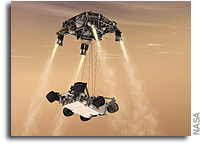NASA Official’s Unconfirmed Claim About the Mars Curiosity Rover Landing and Internet Traffic

It would seem that NASA may have had a profound effect upon Internet usage during the landing of the Mars Curiosity Rover – at least that is what Jim Green, the head of its Planetary Science Division, has said.
According to a Tweet by @RPISciDean (Laurie Leshin) on 24 September 2012 during a meeting of the National Academies of Science Committee on Astrobiology and Planetary Science:
“From Jim Green at #CAPS: Traffic on the ENTIRE INTERNET increased by 30% during landing of @MarsCuriosity — wow! Go #MSL!”
I asked NASA PAO if they could confirm Jim Green’s claim – as relayed by Laurie Leshin. They replied that “NASA Public Affairs does not know where Jim Green got this information nor can we confirm it.”
This would be a rather remarkable accomplishment for NASA – rivaling the ~ 1 billion TV audience for the Apollo 11 landing. As such, one would think that the agency would be much more vocal about the impact of Curiosity’s landing on global Internet traffic – if Jim Green’s statement is accurate, that is.
Now that NASA has officially cast doubt on the veracity of this claim, It would be nice if Jim Green would explain where he got this information – or admit that he made a mistake.
Update: According to NASA PAO, Jim Green was mistaken in referring to a “30% increase in traffic on the ENTIRE INTERNET”. Instead, there was a traffic spike on Akami around 2 am EDT on 6 Aug 2012 of “31% above normal” with regard to what traffic would normally be on certain portions of Akami (not the entire Internet). Akami handles a large portion of global Internet traffic at any given time. That said, NASA PAO says that during the Curiosity landing that thy doubled their previous high for peak webcast stream traffic. Indeed, i48 hours there distributed more than 1 petabyte of data. But Jim Green’s claim that the entire Internet surged by 30% due to Curiosity-related traffic was simply inaccurate.








